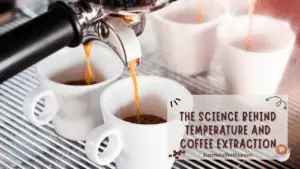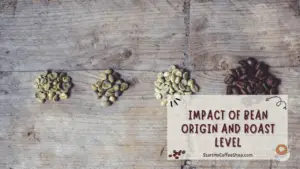Coffee is a ritual, an experience, and a sensory delight. Whether you are a coffee connoisseur or simply appreciate a good cup of joe, understanding the nuances of brewing will elevate your coffee game. The temperature at which you prepare your brew is a crucial factor that significantly affects its flavor and quality.
To best extract the flavors of coffee and achieve a balanced cup, you should brew it at temperatures ranging from 195°F (90°C) to 205°F (96°C). This temperature range allows for optimal solubility of coffee compounds without over-extraction or scorching, resulting in a balanced and flavorful cup of coffee.
The Science Behind Temperature and Coffee Extraction

Coffee, a favorite beverage used by millions of people worldwide, is a complex mixture of flavors that may be unlocked, not just a straightforward combination of water and beans. Unassuming coffee beans have a wealth of volatile substances, acids, and oils that individually contribute to the flavor profile of the beverage. The brewing process serves as an alchemist, pulling out and fusing these ingredients with water to create a wide range of flavors.
In this big coffee chemistry, temperature assumes the role of the main protagonist. It exercises control over the extraction procedure, a skillful dance of solubility in which substances are persuaded to mix with water. A chemical waltz that is orchestrated by the temperature takes place as the water and coffee grounds come into contact. When the extraction pressure is too high, it becomes aggressive, bringing out bitter and harsh notes that overshadow the delicate nuances. Too low, and the dance falters, leaving a tasteless, unimpressive beverage behind.
Finding the ideal temperature sweet spot that brings out the greatest tastes in the coffee beans is the key to perfect coffee brewing. At temperatures between 195°F (90°C) and 205°F (96°C), a melodious symphony of solubility is performed. The appropriate proportion of acids, oils, and aromatic components dissolve when heated, combining to create an entrancing song that stimulates the senses.
The temperature has an impact on how quickly the coffee grounds are extracted when the water circulates them. Flavors that are delicate and complex blossom and make their way into the cup. The finished product is a delicious concoction of expertly arranged notes that appeals to the palate in just the right way.
Each move in this complex coffee ballet is important, and temperature assumes the role of a conductor, guiding the performance. For every budding barista and coffee lover, temperature control becomes crucial. They measure, tweak, and fine-tune the water’s heat in their pursuit of perfection to produce consistently exceptional cups of coffee, each one a unique masterpiece.
Read more about: Start-up Coffee Shop Cost: Calculating the Buzz
The Role of Solubility in Coffee Brewing
The degree to which the coffee components can dissolve in water is determined by solubility, an important notion in the realm of coffee brewing. Each coffee bean has a symphony of chemicals, each with its specific solubility characteristics, ranging from aromatic oils and acids to delicate tastes. The secret to making coffee is getting these components to smoothly combine with water to create an aromatic mixture that is pleasing to the palate.
The temperature can affect how quickly these compounds dissolve by acting as the conductor in this solubility symphony. Higher temperatures make the components of the coffee more receptive to the water’s embrace and more willing to surrender their flavors. However, this dance calls for dexterity because too much heat can cause over-extraction, filling the cup to the brim with bitterness and unpleasant flavors.
Lower temperatures, on the other hand, make the compounds more wary and hesitant to hug the water. The result is a weakly extracted brew that lacks the full range of flavors that coffee beans can provide. Finding the sweet spot, or the ideal temperature range that promotes just the correct level of solubility, is therefore challenging.
The temperature’s impact gently controls the solubility performance as the water envelops the coffee grinds and draws out the priceless tastes inside. It makes sure that the interaction of the various coffee components with the water is harmonic and that each one adds its special flavor to the finished brew.
Each coffee bean’s potential is revealed in this enthralling solubility play, revealing the complex tastes that lurk beneath. The ability to manipulate temperature turns into the barista’s hidden weapon as they deftly adjust the heat of the water to maximize solubility and produce a consistently delicious cup of coffee.
Avoiding Over-Extraction and Scorching
Understanding the impact of temperature management on the brewing process is crucial to avoiding unfavorable results in the search for the ideal cup of coffee. Over-extraction, a phenomenon that occurs when bitter and astringent flavors overwhelm the delicate and nuanced nuances that give each coffee its individuality, can be caused by brewing coffee at extremely high temperatures. The result is a flavor sensation that falls short of the beans’ full potential.
The effects of roasting coffee owing to exceedingly high temperatures are disastrous. Due to the tremendous heat, the priceless coffee chemicals are destroyed, leaving burnt flavors and an unappealing aftertaste. Such undesirable results dilute the flavor of the coffee beans, resulting in a brew that doesn’t arouse the joy and satisfaction that a properly prepared cup of coffee ought to.
The full potential of coffee can be unlocked within the boundaries of this optimal temperature range, according to coffee connoisseurs. The extraction procedure turns into a ballet in which the desired compounds are skilfully extracted while the bitter and undesirable ones are left behind. As a result, you get a cup of coffee that is balanced, rich, and deep—a true tribute to the skill of using the proper temperature for brewing.
Impact of Bean Origin and Roast Level

The ideal temperature range is a helpful place to start in the complex world of coffee brewing, but that is not where the journey to making the ideal cup of coffee ends. Beyond the broad parameters, there are a plethora of variables that affect the brewing procedure, enhancing the complexity and richness of the coffee experience.
The place of origin and degree of roasting of the coffee beans are two important factors. various parts of the world’s coffee produce various flavors and fragrances. For instance, African coffees frequently have bright, fruity aromas, whereas Central and South American coffees could have nutty, chocolatey undertones. These flavor characteristics are a result of the distinctive terroir, growing environment, and processing techniques used to produce coffee beans.
The degree of roast is very important in determining the flavor profile of the coffee. Lighter roasts retain more of the bean’s natural characteristics and produce subtle, complex nuances that highlight the origin of the coffee. Darker roasts, on the other hand, produce robust, rich flavors with notes of caramelization and smokiness. The potential of the coffee is unlocked differently at each roast level, providing a wide variety of flavor experiences.
Small changes in the brewing temperature are frequently required to bring out the finest in coffee beans. A slightly lower brewing temperature is advised for lighter roasts. By avoiding any over-extraction that would diminish the beans’ distinctive traits, this strategy helps highlight the nuanced and complex flavors of the beans.
Darker roasts profit from brewing at a slightly higher temperature. The intensified qualities of the coffee are completely realized in the cup because of the higher heat, which enables a more thorough extraction of powerful and bold tastes.
Coffee lovers set out on a journey of research and experimentation in this delicate ballet of temperature and flavor. Understanding coffee origins and roast profiles intertwines with the skill of temperature management to provide specialized brewing techniques that highlight the unique characteristics of each coffee batch.
Read more about: Start-up Cost for a Coffee Shop: A Penny for Your Cup
Brewing Methods and Temperature Control
There are numerous ways to extract the alluring tastes that are concealed within coffee beans in the diversified realm of coffee brewing. Pour-over, French press, espresso, or drip coffee all have different properties that call for specific temperature considerations to achieve optimum results.
The espresso maker, on the other hand, is the master of pressure brewing. Espresso machines frequently brew at the higher end of the temperature range to enhance extraction in a shorter amount of time. High pressure and elevated heat quickly extract the concentrated flavors from the coffee, creating a potent shot of espresso that serves as the base for many coffee-based drinks.
The French press method, on the other hand, represents a more hands-on and experiential approach to brewing. Here, considerable attention must be paid to temperature control during brewing to prevent the extraction from being impeded by extremely low or high temperatures. Through careful temperature control, a French press brew can be produced that is both balanced and robust.
The popular drip coffee maker, which is a common fixture in many homes, also depends on a constant temperature for the duration of the brewing process. When the temperature is kept within the advised range, the drip method’s accessibility and simplicity nevertheless provide a tasty cup even though it lacks the exact control of pour-over.
The Art of Temperature Measurement:
Precision is a defining characteristic that distinguishes an average brew from an exceptional one in the pursuit of coffee quality. A fundamental to releasing the full potential of the coffee beans, accurate temperature measurement emerges as an essential element for accuracy and repeatability in coffee brewing.
An alternative for the discriminating coffee drinker is a premium brewing system with built-in temperature control. The water will stay at the proper temperature during the whole brewing process thanks to this cutting-edge brewing equipment. The benefit of these tools is that they provide uniformity, leaving no opportunity for variations or guesswork.
Coffee lovers can better regulate the extraction process by carefully controlling the temperature during brewing. The proper temperature controls the solubility dance as the water interacts closely with the coffee grinds, softly encouraging the flavors to meld together. Every sip of this cup exhibits well-balanced, subtle, and delicious tastes because over- and under-extraction are minimized.
Knowing that the next cup will be equally as amazing as the previous is comforting when the temperature is consistent. The enjoyment and satisfaction of drinking coffee are enhanced with each brew thanks to careful temperature management.
Experimentation and Personal Preference

Coffee is a private experience, a symphony of flavors that speaks to each person uniquely. Please keep in mind that experimentation is not only acceptable but actively encouraged as you go through your senses. Every brew offers the chance to explore the universe of many flavors hiding inside the coffee beans.
Start your search inside the ideal temperature range and use it as a guide to establish the groundwork for a delicious cup of coffee. The coffee chemicals elegantly dissolve within this range, and the extraction procedure reveals a delicate fusion of tastes. This well-balanced beverage gives a hint of what is to come.
Take note of the intricacies and subtleties that entice your taste buds as you relish each sip. Do you like a cup with a brighter acidity or one with a mellower, more robust flavor? Do you go toward fruity and floral aromas or do you favor the cozy embrace of dark, chocolatey undertones? The allure of coffee rests in its capacity to accommodate certain tastes, providing a personalized experience that honors your individuality.
Consider gradually adjusting the temperature for each brewing endeavor, letting your flavor experience develop naturally. As you perfect your brewing technique, you might discover that slightly lower temperatures improve delicate floral notes while a little extra heat brings out the natural richness of the beans. Enjoy this exploration as it brings you one step closer to finding the ideal cup.
Read more about: Start-up Cost for a Small Coffee Shop: Breaking Down the Price Barrier
Frequently Asked Questions

What temperature range is ideal for making coffee?
Between 195°F (90°C) and 205°F (96°C) is the ideal temperature range for brewing coffee and obtaining the optimum flavor and extraction. A balanced and tasty cup of coffee is produced by staying within this range, which guarantees the best solubility of coffee constituents without over-extraction or burning.
Can I brew coffee at temperatures other than those suggested?
You can experiment with modest temperature adjustments to suit your taste preferences, even though the suggested temperature range yields the best results for the majority of coffee beans and brewing techniques. However, brewing too much above or too much below the ideal range may result in over- or under-extraction, which will impact the flavor balance.
How can I precisely regulate the brewing temperature at home?
Consider buying a dependable thermometer or utilizing a premium coffee maker with built-in temperature control to precisely regulate the brewing temperature at home. To extract the greatest flavors from your coffee beans and produce a consistently delicious cup of coffee, measuring the water temperature provides consistency in your brewing process.
To learn more on how to start your own coffee shop, check out my startup documents here.
Disclaimer: The information provided by StartMyCoffeeShop.com (“The Site”) is for general informational purposes only. All information on the Site is provided in good faith. However, we make no representation or warranty of any kind, express or implied, regarding the accuracy, adequacy, validity, reliability, availability, or completeness of any information on the Site. Under no circumstance shall we have any liability to you for any loss or damage of any kind incurred as a result of the use of the Site or Reliance on any information provided on the Site. Your use of the Site and reliance on any information on the Site is solely at your own risk. This blog post is for educational purposes only and does not constitute legal advice. Please consult a legal expert to address your specific needs. Terms and Conditions. (https://startmycoffeeshop.com/terms-and-conditions/)

Hi! I’m Shawn Chun
My adventure in coffee began when I first launched my first coffee shop back in the early 2000s. I had to figure out so many things on my own and to make it worse within 2 years of opening two large corporate coffee chains moved in just blocks away from me!
As I saw smaller and even some larger coffee shops in the neighborhood slowly lose customers to these giant coffee chains and slowly close up shop, I knew that I had to start getting creative…or go out of business.
I (like you may be) knew the coffee industry well. I could make the best latte art around and the foam on my caps was the fluffiest you have ever seen. I even had the best state-of-the-art 2 group digital Nuova Simonelli machine money could buy. But I knew that these things alone would not be enough to lure customers away from the name brand established coffee shops.
Eventually, through lots of trial and error as well as perseverance and creativity I did find a way to not only survive but also thrive in the coffee/espresso industry even while those corporate coffee chains stayed put. During those years I learned to adapt and always faced new challenges. It was not always easy, however, in the end, I was the sole survivor independent coffee shop within a 10-mile radius of my location. Just two corporate coffee chains and I were left after that year. All told the corporate coffee chains took down over 15 small independent coffee shops and kiosks and I was the last one standing and thriving.
Along the years I meet others with the same passion for coffee and I quickly learned that it is not only “how good a barista is” that makes a coffee shop successful, but the business side of coffee as well.
Hence why I started this website you are on now. To provide the tools and resources for up and coming coffee shop owners to gain that vital insight and knowledge on how to start a coffee shop successfully.
Stick around, browse through my helpful blog and resources and enjoy your stay! With lots of LATTE LOVE!
Shawn







